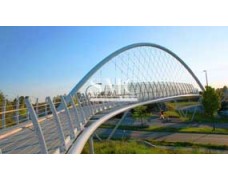
- Oil Pipeline
- Water Pipeline
- Gas Pipeline
- Boat and Mooring Accessories
- Metal for Decoration
- Transformer Components
- Heat Exchanger Pipe
- Air Conditioning Spare Parts & Accessories
- Boiler
- Kitchen and Bathroom Appliance
- Metal for Household Appliance
- Solar Power Appliance
- Elevator
- Roofing and Ceiling
- Cable
- Tank
- Packaging
- Machinery and Equipment Spare Parts & Accessories
- Mold
- Automobile Parts
- Rail and Crane Rail
- Hardware Fitting
- Abrasive
- Road Construction Equipment
- Electronic Components
- Construction and Decoration Materials
- Doors and Windows
- Refrigerators
钢梁桥
1. Highest national qualification--Grade One Steel Structure Engineering Professional Contractors
2. Able to undertake all kinds of steel structure projects without limitation in span, contract sum, construction area or total weight of construction
3. Obtained the Construction Design Qualification
4. Experienced in overseas project
5. Co-development with University Lab
6. 85000㎡ workshop, about 3000 workers to ensure delivery time
General
A beam and slab, or composite bridge is one where a reinforced concrete deck slab sits on top of steel I-beams, and acts compositely with them in bending. There are two principal forms of this beam and slab construction; multi-girder construction and ladder deck construction. Between them, they account for the majority of medium span highway bridges currently being built in the China, and are suitable for spans ranging from 13m up to 100m. The choice between the two forms depends on economic considerations and site-specific factors such as form of intermediate supports and access for construction.
Increasingly, such composite bridges are adopting ‘integral construction’, where the deck is rigidly connected to the abutments. This eliminates the need for expansion joints and bearings, which minimises future maintenance requirements.
In some situations, notably for railway bridges, the depth between the trafficked surface (or rails) and the underside of the bridge is severely constrained and there is little depth available for the structure. In these circumstances, ‘half-through’ construction is used.
Product Information
SMC always use high-quality structure steel that is readily available worldwide in certified grades, in products of various shapes and sizes. Prefabrication of steelwork in controlled factory conditions leads to high quality work at minimum cost. The excellent quality control is achieved through a thorough testing regime at the steel mills and during the fabrication processes of cutting and drilling, assembly, welding, and protective treatment. The quality assurance that is attained should give confidence to all clients and engineers who specify steel for their bridge project.
Steel material is supplied in two product forms – ‘flat products’ (steel plate and strip) and ‘long products’ (rolled sections, either standard open sections such as beams, channels, angles, etc or hollow sections). For structural use in bridges these products are inevitably cut (to size and shape) and welded, one component to another. In the structure, the material is subject to tensile and compressive forces. Structural steel generally responds in a linear elastic manner, up to the ‘yield point’ and thereafter has a significant capacity for plastic straining before failure. All these aspects of steel material are utilised by the designer of a steel bridge.
Construction
A wide range of construction methods and sequences are available for steel bridges. They can be lifted, piece-by-piece, by cranes or strand jacks; they can be launched by sliding or rolling from the abutment; or they can be slid or transported into position. In some instances a combination of erection methods are needed; these are called ‘Hybrid schemes’. Steel offers flexibility in terms of erection sequence and certainty in terms of the programme, once erected, the steel girders provide platforms for subsequent deck construction operations. That can reduce the construction time.
Offsite prefabrication of steel components means that construction time on site often in hostile environments. The speed of bridge construction made possible by steel allows disruption to road and rail users to be kept to a minimum. The relatively low weight of structural steel components permits the erection of large sections; in some circumstances complete bridges can be moved into position overnight. Speed of steel bridge construction also benefits main contractors even on ‘green field’ sites, as it allows them to establish and maintain access for haul roads.
here
for
price
We will contact with you within 8 hours










